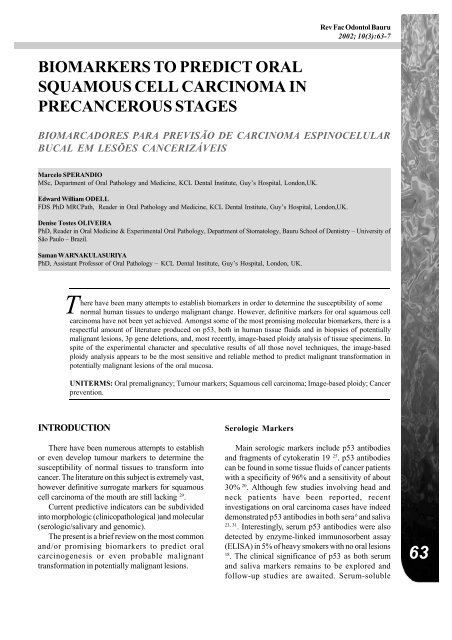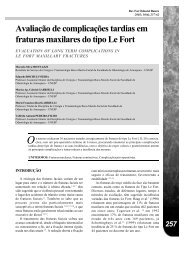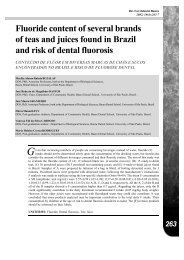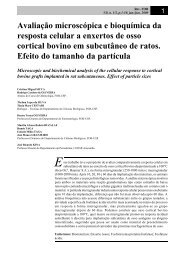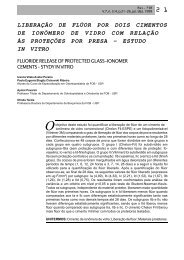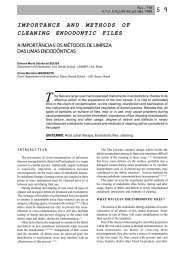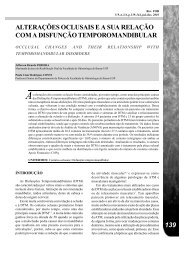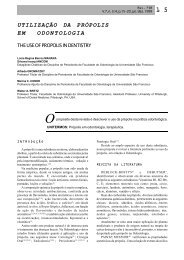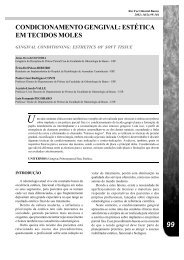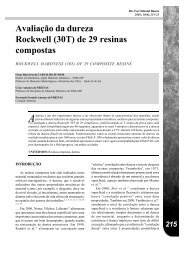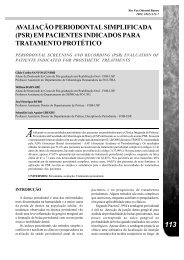biomarkers to predict oral squamous cell carcinoma in precancerous ...
biomarkers to predict oral squamous cell carcinoma in precancerous ...
biomarkers to predict oral squamous cell carcinoma in precancerous ...
You also want an ePaper? Increase the reach of your titles
YUMPU automatically turns print PDFs into web optimized ePapers that Google loves.
Rev Fac Odon<strong>to</strong>l Bauru2002; 10(2):63-7(LOH), which may conta<strong>in</strong> putative tumoursupressor genes <strong>in</strong> <strong>oral</strong>, oropharyngeal, and otherhead and neck cancers 25 .Follow<strong>in</strong>g the pioneer studies by Partridge andcolleagues 14 , deletions <strong>in</strong> the long arm ofchromosome 3 <strong>in</strong> <strong>oral</strong> cancer has now beenhighlighted as a very common event, occurr<strong>in</strong>g <strong>in</strong>approximately 70% of all SCC 15 . Furthermore, itwas shown that allelic imbalance or LOH <strong>in</strong> 3p werepresent <strong>in</strong> dysplastic mucosa but not <strong>in</strong> normalmucosa and, therefore, an early event <strong>in</strong> the processof carc<strong>in</strong>ogenesis 5 . In potential malignancies,deletions of 3p were rather frequent, especially whendysplasias recurred, or when SCC developed. 3pdeletions thus might serve as a biomarker <strong>to</strong> identifylesions that may relapse or even undergo malignantchange 32 . Moreover, it has been demonstrated thatif one <strong>in</strong>troduced an <strong>in</strong>tact human chromosome 3<strong>in</strong><strong>to</strong> different tumorigenic <strong>cell</strong> l<strong>in</strong>es, tumourigenicitywould be suppressed <strong>in</strong> each <strong>cell</strong> l<strong>in</strong>e, with significantdecrease <strong>in</strong> <strong>in</strong> vitro growth rate and morphologicchanges 24 .Loss of loci <strong>in</strong> chromosome 9p and amplificationof 11q have also been related <strong>to</strong> SCC of head andneck. However, no reports have been found <strong>in</strong>potentially malignant lesions. Both have shownstrik<strong>in</strong>g prognostic value for cancer rather than<strong>predict</strong>ive of development of cancer.Image-based ploidy analysisVery recently image-based ploidy analysis hasbeen shown highly effective <strong>to</strong> <strong>predict</strong> malignanttransformation with high sensitivity and specificityand can be applied rout<strong>in</strong>ely <strong>to</strong> biopsy samples <strong>in</strong> ahospital sett<strong>in</strong>g.Cumulative evidence po<strong>in</strong>ts <strong>to</strong> abnormalities <strong>in</strong>the number of chromosomes (aneuploidy) as a causerather than a consequence of malignanttransformation 21 . Notwithstad<strong>in</strong>g this, consider<strong>in</strong>gthat cancer and genetic <strong>in</strong>stability are almostsynonyms, mutations <strong>in</strong> genes that control segregationof chromosomes dur<strong>in</strong>g mi<strong>to</strong>sis and/or centrosomalaberrations are critical <strong>to</strong> determ<strong>in</strong>e malignantchange. As a matter of fact, aberrant chromosomalsegregation occur exclusively <strong>in</strong> aneuploid tumour<strong>cell</strong>l<strong>in</strong>es, caus<strong>in</strong>g, therefore, aberration of DNAcontent (ploidy) <strong>to</strong> play an essential role oncarc<strong>in</strong>ogenesis 21, 22 .A Norwegian study has recently revealed whatappears <strong>to</strong> be the first successful attempt <strong>to</strong> establisha methodology for prognostication of potentiallymalignant lesions of the <strong>oral</strong> mucosa. One hundredand fifty patients with an <strong>in</strong>itial diagnosis ofleukoplakia had their lesions analyzed by image-basedploidy and were followed up for 9 years. Out of the27 aneuploid lesions, 21 underwent malignanttransformation. From the 20 tetraploid lesions, 12changed <strong>in</strong><strong>to</strong> the malignant phenotype, whilst only 3out of the 103 diploid lesions became malignant 21 .Although DNA ploidy measurements by imagecy<strong>to</strong>metry is a very crude method, with a coefficien<strong>to</strong>f variation of 3-5%, which translates <strong>to</strong> 1-2chromosomes per nucleus, the long follow-up timepresented <strong>in</strong> this study supports the notion that DNAcontent is a highly sensitive and a specific markerfor <strong>predict</strong><strong>in</strong>g the subsequent occurrence of an <strong>oral</strong><strong>squamous</strong> <strong>cell</strong> <strong>carc<strong>in</strong>oma</strong> 22 .ACKNOWLEDGEMENTSThe authors are thankfull <strong>to</strong> Dr. Jonathan Millerfor DNA image (www.jonathanpmiller.com) and Dr.Patrick O. Brown (Howard Hughes MedicalInstitute - Stanford University) for DNA microchipimage. The images are illustrate <strong>in</strong> the front page ofthis journal.RESUMOInúmeras tentativas têm sido feitas paraestabelecer ou mesmo desenvolver marcadores paradeterm<strong>in</strong>ar a susceptibilidade de tecidoshis<strong>to</strong>logicamente normais sofrerem transformaçãomaligna. A literatura é extremamente vasta noassun<strong>to</strong>, mui<strong>to</strong> embora um marcador def<strong>in</strong>itivo parao <strong>carc<strong>in</strong>oma</strong> de boca a<strong>in</strong>da não tenha sidoestabelecido. Os <strong>in</strong>dicadores atuais podem sersubdivididos em morfológicos (cl<strong>in</strong>ico-pa<strong>to</strong>lógico) emoleculares (serológicos/salivares e genômicos).Dentre eles, destacam-se o p53 tan<strong>to</strong> no soro comono sítio da lesão, a deleção de porções do gene 3p e,mais recentemente, a análise de ploidia baseada emimagem. Embora <strong>to</strong>dos sejam cientificamenteobje<strong>to</strong>s de muita pesquisa e resultadosespeculatórios, a ploidia baseada em imagem pareceser o mé<strong>to</strong>do mais sensível e confiável para prevertransformação maligna em lesões cancerizáveis damucosa bucal.UNITERMOS: Lesões cancerizáveis;Marcadores tumorais; Carc<strong>in</strong>oma esp<strong>in</strong>o-celular;Análise de ploidia por imagem; Câncer, prevenção.65
Sperandio M, Odell E W, Oliveira D T, Warnakulasuriya SBIOMARKERS TO PREDICT ORAL SQUAMOUS CELL CARCINOMA IN PRECANCEROUS STAGES66REFERENCES1- Axell T, P<strong>in</strong>dborg JJ, Smith CJ, Waal Van Der I. InternationalCollaborative Group on Oral WHITE Lesions. Oral white lesionswith special reference <strong>to</strong> <strong>precancerous</strong> and <strong>to</strong>bacco-relatedlesions: conclusions of an <strong>in</strong>ternational symposium held <strong>in</strong>Uppsala, Sweden, May 18-21, 1994. J Oral Path Med 1996;25: 49-54.2- Axell T. Occurrence of leukoplakia and some other whitelesions among 20,333 adult Swedish people. Comm Dent OralEpidemiology 1987; 15: 46-51.3- Axell T, Holmstrup P, Kramer IRH, P<strong>in</strong>dborg JJ, Shear M.International sem<strong>in</strong>ar on <strong>oral</strong> leukoplakia and associated lesionsrelated <strong>to</strong> <strong>to</strong>bacco habits. Comm Dent Oral Epidemiol 1984;12:145-54.4- Boyle JO, Hakim J, Koch W; et al. The <strong>in</strong>cidence of p53mutations <strong>in</strong>creases with progression of head and neck cancer.Cancer Res 1993; 53:4477.5- Emilion G, Langdon JD, Speight P, Partridge M. Frequentgene deletions <strong>in</strong> potentially malignant <strong>oral</strong> lesions. Br J Cancer1996; 73:809.6- Friedrich RE, Barttel Friedrich S, Plambeck K, Bahlo M,Kladpor R. p53 au<strong>to</strong>-antibodies <strong>in</strong> the sera of patients with <strong>oral</strong><strong>squamous</strong> <strong>cell</strong> <strong>carc<strong>in</strong>oma</strong>. Anticancer Res 1997; 17: 3183.7- Gupta PC, Mehta FS, Daftary DK; et al. Incidence rates of<strong>oral</strong> cancer and natural his<strong>to</strong>ry of <strong>oral</strong> <strong>precancerous</strong> lesions <strong>in</strong> a10-year follow-up study of Indian villagers. Comm Dent OralEpidemiol 1980; 8: 287-333.8- Harris, CC The 1995 Walter Hubert Lecture – molecularepidemiology of human cancer: Insight from mutational analysisof the p53 tumour-suppressor gene. Br J Cancer 1996; 73: 261.9- Hussa<strong>in</strong> SP, Harris CC. Molecular epidemiology of humancancer: contributions of mutational spectra studies of tumorsuppressor genes. Cancer Res 1998; 58: 4023.10- Kaur J, Srivastava A, Ralhan R. Prognostic significance ofp53 prote<strong>in</strong> overexpression <strong>in</strong> betel and <strong>to</strong>bacco related <strong>oral</strong>oncogenesis. Int J Cancer; 1998; 79: 370.11- Kramer IRH, Lucas RB, P<strong>in</strong>dborg JJ, Sob<strong>in</strong> LH. WhoCollaborat<strong>in</strong>g Centre For Oral Precancerous Lesions. Def<strong>in</strong>itionof leukoplakia and related lesions: an aid <strong>to</strong> studies on <strong>oral</strong>precancer. Oral Surg 1978; 46: 518-39.12- Kuffer R, Lombardi T. Premalignant lesions of the <strong>oral</strong>mucosa. A discussion about the place of <strong>oral</strong> <strong>in</strong>traepithelialneoplasia (OIN). Oral Oncol 2002; 38(2):125-30.13- Niemann AM, Paulsen JI, Lippert BM, Henze E, GoeroeghT, Gottschlich S, Werner JA. CYFRA 21-1 <strong>in</strong> patients withhead and neck cancer. In: Werner JA, Lippert BM, Rudert HH(eds): Head and neck cancer: advances <strong>in</strong> basic research. London,Elsevier, 1996; p. 529.14- Partridge M, Kyguwa S, Langdon JD. Frequent deletion ofchromosome 3p <strong>in</strong> <strong>oral</strong> <strong>squamous</strong> <strong>cell</strong> <strong>carc<strong>in</strong>oma</strong>. Eur J Cancer;1994; 30B: 248.15- Partridge M, Warnakulasuriya S. The biology of cancer. In:Ward Booth P, Schendel SA, Hausamen JE. MaxillofacialSurgery. Ed<strong>in</strong>burgh, Churchill Liv<strong>in</strong>gs<strong>to</strong>ne, 1999; p.309.16- P<strong>in</strong>dborg JJ, Reibel J, Holmstrup P. Subjectivity <strong>in</strong>evaluat<strong>in</strong>g <strong>oral</strong> epithelial dysplasia, <strong>carc<strong>in</strong>oma</strong> <strong>in</strong> situ and <strong>in</strong>itial<strong>carc<strong>in</strong>oma</strong>. J Oral path; 1985; 14: 698-708.17- Q<strong>in</strong> GZ, Park JY, Lazarus P. A high prevalence of p53mutations <strong>in</strong> pre-malignant <strong>oral</strong> erythroplakia. Int J Cancer 1999;80: 345.18- Ralhan R, Nath N, Agarwal S, Wasylyc B, Shukla NK.Circulat<strong>in</strong>g p53 antibodies as early markers of <strong>oral</strong> cancer:correlation with p53 alterations. Cl<strong>in</strong> Cancer Res 1998; 17:3147.19- Silverman S, Bhargava K, Mani NJ, Smith LW, MalaowallaAM. Malignant transformation and natural his<strong>to</strong>ry of <strong>oral</strong>leukoplakia <strong>in</strong> 57,518 <strong>in</strong>dustrial workers of Gujarat, India.Cancer 1976; 38: 1790-5.20- Soussi T. p53 antibodies <strong>in</strong> sera of patients with varioustypes of cancer. A review. Cancer Res 2000; 60: 1777.21- Sudbo J, Kildal W, Risberg B, Koppang HS, Danielsen HE,Rith A. DNA content as a prognostic marker <strong>in</strong> patients with<strong>oral</strong> leukoplakia. N Engl J Med 2001; 344( 17): 1270-8.22- Sudbo J, Ried T, Bryne M, Kildal W, Danielsen H, ReithA. Abnormal DNA content <strong>predict</strong>s the occurrence of<strong>carc<strong>in</strong>oma</strong>s <strong>in</strong> non-dysplastic <strong>oral</strong> white patches. Oral Oncol;2001; 37(7): 558-65.23- Tavassoli M, Brunel N, Mahr R, Johnson NW, Soussi T.P53 antibodies <strong>in</strong> the saliva of patients with <strong>squamous</strong> <strong>cell</strong><strong>carc<strong>in</strong>oma</strong> of the <strong>oral</strong> cavity. Int J Cancer 1998; 78: 390.24- Uzawa N, Yoshida MA, Hosoe S, Hosimura M, AmagasaT, Ikeuchi T. Functional evidence for <strong>in</strong>volvement of multipleputative tumour suppressor genes on the short arm ofchromosome 3 <strong>in</strong> the human <strong>oral</strong> <strong>squamous</strong> <strong>cell</strong> carc<strong>in</strong>ogenesis.Cancer Genet Cy<strong>to</strong>genet 1998; 107:125.25- Vogelste<strong>in</strong> B, K<strong>in</strong>zler WK. Cancers of the <strong>oral</strong> cavity andpharynx. In: The genetic basis of human cancer. 2 . ed. NewYork 2002; p. 773-84.26- WaaL van der, I., Schepman KP, Meij van der EH, SmeeleLE. Oral leukoplakia: a cl<strong>in</strong>icopathological review. Oral Oncol1997; 33(5): 291-301.27- Warnakulasiriya S, Speight PM, Tavassoli M, Elam<strong>in</strong> F,Penhallow J, Johnson NW. Association between proliferativeverrucous leukoplakia, p53 prote<strong>in</strong> and HPV <strong>in</strong>fection. OralDis 1997; 3(2):S28.28- Warnakulasuriya S. p53 and <strong>oral</strong> precancer – a review, <strong>in</strong>Varma AK (ed): Oral Oncol, vol VI. Proceed<strong>in</strong>gs of the SixthInternational Congress on Oral Cancer, New Delhi, Macmillan,1998; p.93.


